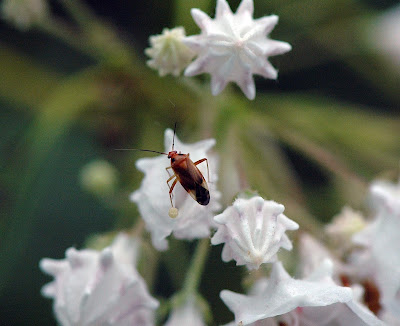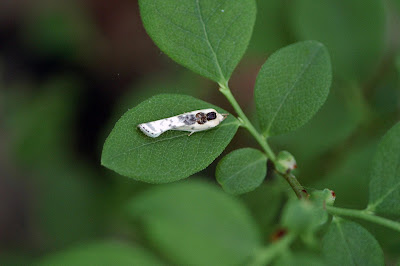30 years ago when surveying Ash Cave State Park, I remember seeing a little purple flower called Meehenia. Since them I could never find it to photograph. Turns out my timing was simply off. They are now peaking throughout the park. So I got busy 'peeking'.
Meehenia, Meehenia cordata, is a member of the Mint family. It grows low to the ground and is often obscured by taller plants. The flowers are pink to purple, and the lower lip looks like a hairy tongue.
Cherish the wild places that you have, because over time some of them may disappear. Also cherish your memory. I recall in 1980-81, a small 100ft strip of grass down the road from Ash Cave that contained this plant, Indian Paintbrush, Castilleja coccinea. What were the chances it was still there?
Sure enough, there they were, still preserved up on a rise next to a power line. The divided leaves are found lower on the plant. It's the bracts that give it the red-orange look. The actual flowers are the green structures looking like antennae. The blooms peaked a week ago, and are normally yellow. This plant is also called Scarlet Blanket or Painted Cup. I prefer Paintbrush, but all these common names are also applied to different species in the south and west.
Also mixed in this upland forest edge was a profusion of Yellow Stargrass, Hypoxis hirsuta.
I mentioned in my last post how even the most mundane looking areas can produce interesting things if you just explore. But sometimes you have to seek out those "special" areas you've heard about. I finally decided to check out a nature preserve, now open to the public, called Rhododendron Cove near Wahkeena.
While driving down the highway, (notice I didn't say speeding down the highway). I think I'm the last man alive who actually pays attention to speed limits. Anyway, my eye caught a field of all yellow. I knew it wasn't Butterweed, and thought maybe Yellow Bedstraw. Upon stopping, it turned out to be something non-native. Oh well, it was new for the camera.
This is Charlock, Brassica kaber, another Mustard. The leaves are heavily serrated, and look like they want to divide into sections. They do on the lower portions of the plant.
Upon arriving at Rhododendron Cove, I found the path that leads up to the preserve. There were enough interesting things in just that spot to do a whole different post, but I'll keep many of those for another time.
I was greeted by this Honey Locust, Gleditsia triacanthos. As common as this tree is, I had never photographed this 'hairy caterpillar' bloom.
Whether it be dry or wet areas, I always seem to find Blue-eyed Grass everywhere. What I really need to do is learn how to separate all the species, I simply haven't worked on them.
It's hard to argue the beauty of Yellow Iris, Iris pseudacorus, even though this is non-native. They often escape from cultivation into wet ditches.
As I turned up the hill, I began to see some other familiar plants. Mayapple, Podophyllum peltatum, is now past bloom and beginning to produce its namesake, a green apple like fruit. While green they are poisonous. They are edible once they turn yellow.
Wild Madder, Galium mollugo, is sometimes called White Bedstraw. This one is non-native. Bedstraws have extremely tiny 4-petaled flowers.
Since Bedstraws all look similar in their flowers, you need to look at two things to separate them. How many leaves in a whorl, and are the stems rough or smooth. If I ever get enough photos, I'll do a post on all of them. Wild Madder averages 8 leaves a whorl. The leaves feel thick and rubbery to the touch.
In contrast is this native species with 4-whorled, very broad leaves. It's called Wild Licorice, Galium circaezans. The whole plant is fuzzy to the touch, not smooth. Notice again in the upper right, just how small the flowers are.
They are so small, it's hard to get a good photo, (well for this amateur anyway). One other hint on identification, this one has green flowers, not white.
Speaking of plants with small flowers, here's one that I missed by about a week. I found a plant still hanging on to a single flower. Recognize it?
Considering just how large the stem and leaves of this plant are overall, you could easily miss the tiny blooms. It's Wild Comfrey, Cynoglossum virginianum. This is an upland dry forest species, and a member of the Boraginaceae family. Flowers in this family have stems curled like a scorpion tail when they first come out.
Rattlesnake-weed, Hieracium venosum.
Deerberry, Vaccinium stamineum. Both of these are indicator species of this site. Not to repeat my Log Cabin Hollow post, but plant communities are determined by those trees most dominant in the canopy. Indicator species reflect what type of habitat you are in. These two tell you that you're in a dry, acidic, upland forest. Also here were other typical clues such as Wintergreen, Huckleberry, Low Blueberry, Serviceberry, Sourwood, Sawbrier, Chestnut Oak.
That's all fine and dandy, but at a turn in the bend along this ridge-top came another indicator, the Mountain Laurel, Kalmia latifolia. This was no surprise, but then I was mesmerized!
Shrub after shrub after shrub. It was overwhelming. I had never seen this many Mt. Laurels in one spot anywhere in Ohio. I know it's called Rhododendron Cove, and yes there were many, (not yet in bloom), but if it were up to me, I would have called this place Mountain Laurel Cove. There had to be a hundred times as many as the Rhododendrons.
I love how the stamens stay hidden down in those red dot cavities. They spring forward like a mouse trap, covering any bee with pollen when they land.
This batch was in more open sunlight. They haven't been blooming longer, as many haven't opened yet. I don't think the acid content of the soil is different here either. Mountain Laurel commonly occurs in both white and pink forms. Cultivated varieties tend to favor the dark pink-red forms.
I didn't see a lot of insects on Mt. Laurel. This Hemiptera though is associated specifically with this plant. In fact it's called the Mountain Laurel Bug, Neolygus laureae. I once had a book on the biology of this bug family. I can't find it, or I'd tell you more about it. Having a library as large as mine, things get lost.
As an acid dweller, Mountain laurel is a poisonous plant. The honey produced is also toxic to humans. Is this the immature of the ML Bug? Can't be sure, but it wouldn't surprise me. To openly walk around this plant carefree, the red color I'm sure, is a warning to any predator.
I did find a few other critters in the woods. This rather drag white moth is an inchworm. It's called the White Spring Moth, Lomographa vestaliata. Besides the caterpillar, broad wings and a narrow skinny body is what puts it in the Inchworm family.
There are many moth families that have representatives that look like bird droppings. This is one of them. It's an Antaeotricha moth, one of the Grass Miners. All the specimens I find are leucillana. A. schlaegeri is about 8 mm larger, but identical in appearance, and often requires genitalia be examined to be positive.
One of my favorite things about Hocking County is showing a group of people why the sandstone outcrops look like this. First I ask them if they all know the behavior of woodpeckers. Then I explain these holes were created by the long extinct, prehistoric Rockpecker. What, not buying it?
































I was diagnosed with Parkinson’s four years ago, and after my symptoms continued to worsen despite medication, I tried a herbal program from NaturePath Herbal Clinic. Over time, I personally noticed improvements in my tremors, balance, and overall energy. Everyone’s experience is different, but if you’re exploring alternative approaches, you can learn more on their site: www.naturepathherbalclinic.com
ReplyDeleteor contact info@naturepathherbalclinic.com